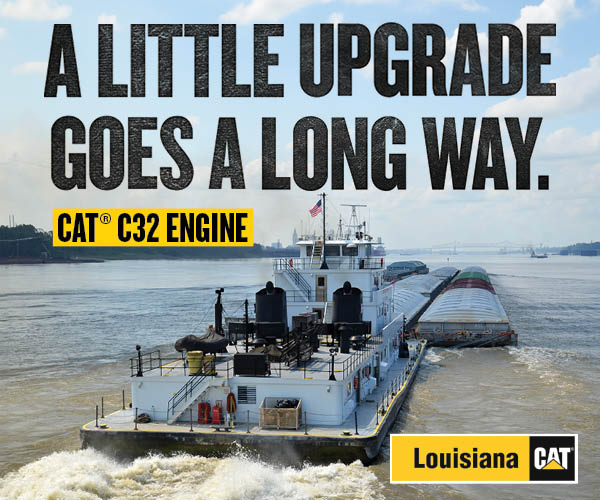Port NOLA Hosts Cargo Conference
The Port of New Orleans hosted its 10th annual Cargo Connections Conference last week, with shippers, ocean carriers and industry leaders gathering in New Orleans’ Warehouse District April 8–10 to discuss commodity trends and challenges facing the nation’s transportation industry.
Brandy Christian, president and CEO of the Port of New Orleans, shared details from the port’s new master plan during her opening address. Christian first emphasized the port’s incredible connectivity across all modes of transportation. In all, the Lower Mississippi River connects the Port of New Orleans to 14,500 miles of waterways. Beyond the waterways, the port is connected to multiple interstate highways and all six Class I railroads.
Christian underscored the significance of the port’s recent acquisition of the New Orleans Public Belt, a short line railroad spanning both sides of the river in New Orleans.
“At the center of not only the port’s decision to acquire and partner deeper with the New Orleans Public Belt, but really what has made us a gateway is the Port of New Orleans’ unprecedented connection to six Class I’s,” Christian said. “We’re the only deepwater port that actually has service to those Class I’s via the New Orleans Public Belt.”
The port also has maintained service from all three major container carrier alliance groups and continues to see growth at its container and cruise terminals.
“I know we are poised for growth over absolutely every line of business,” Christian said.
Christian made clear that containers will be a major point of focus for New Orleans in the years ahead. The Port of New Orleans has tripled its container handling over the past 10 years, Christian said, and plastic resins alone could drive a 25 percent growth in containers at the port by 2020. Seacor AMH moved 16,000 FEUs (40 foot equivalent units) of resin-laden containers via barge in 2017 and has recently added a second weekly service between Baton Rouge and New Orleans. Christian also said she expects to see a second Class I railroad begin service at the port’s intermodal transfer yard very soon. Currently, CN handles all outbound containers at the intermodal yard.
With container growth not only steady but expected to surge, the Port of New Orleans plans to bring its Napoleon Avenue Container Terminal up to its maximum capacity of 1.5 million TEUs (20foot equivalent units), add four new 100-foot gantry cranes and boost gate efficiency for trucking, Christian said.
The port is also in the process of studying the feasibility of adding a second container terminal downriver in St. Bernard Parish. The site under review comprises 675 acres and would serve as both a maritime container terminal and a logistics center.
“By having two container terminals, we’d be able to serve different markets but also create more backup space at both terminals over time,” Christian said. “This terminal would be able to serve a 12,000 TEU ship-plus, but also we will aim to have the capacity to serve all three of our ocean alliances.”
Christian also touched on increasing capacity for handling breakbulk cargoes and also working with economic development partners to foster new production in the region, which would drive increased cargo handling and create jobs.
The Port of New Orleans, Christian said, is planning and investing heavily in its rail service to further enhance its intermodal connectivity between river, road and rail.
“When you synergize those and better coordinate those activities, I think the stronger we’ll be as a real rail gateway,” Christian said.
Keynote Address
Cargo Connections Conference attendees also got to hear from Nick Fafoutis, senior vice president for sales and chief commercial officer for CMA CGM (America). Fafoutis, who delivered the conference’s keynote address, highlighted the state of flux within the ocean carrier industry.
“It’s an exciting time in the shipping industry,” Fafoutis said. “Change is all around us, for the good and for the bad. How we manage that change and how we work together as partners will define our collective success. As we move forward, it’s important to realize how much we need each other.”
Fafoutis said the landscape of the shipping industry in 2018 is quite complex. Ocean carriers have seen capacity shifts, consolidations and acquisitions, alliance shakeups and technological advances. Simply put, Fafoutis said service quality is down while the scale of service is on the rise. And the conversation with regard to ocean carriers remains dominated by rates and capacities, Fafoutis said.
He called for the future among ocean carriers to be different, so they can avoid “the sins of our past.”
“That dynamic between us as shipper and carrier—we need to start to change the conversation, and changes should start right now,” Fafoutis said, later adding, “As an industry, we need to work together, because we do have issues facing this industry, some that are more systemic and structural than others.”
Fafoutis said that creative collaboration could help solve problems like truck driver shortages, container imbalances and chassis shortages.
Fafoutis said one innovative way CMA CGM is working to bring needed containers to South Louisiana is through a partnership with the Kansas City Southern Railroad that will move empties from the Dallas-Fort Worth area to New Orleans.
Fafoutis heaped praises on the partnership between CMA CGM and the Port of New Orleans. He said that in 2013 CMA CGM accounted for 3 percent of the container movement at the port. That percentage is now above 20 percent.



